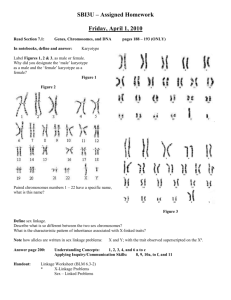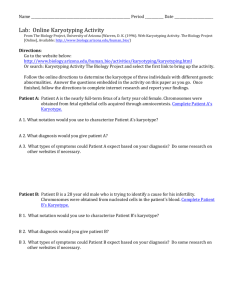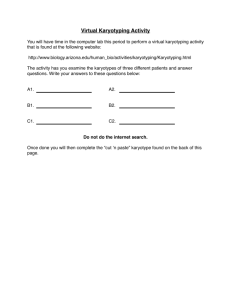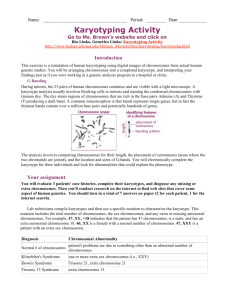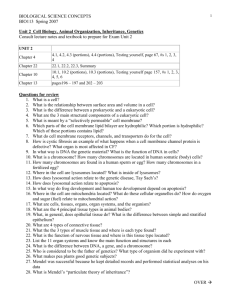29. Karyotype Webquest
advertisement
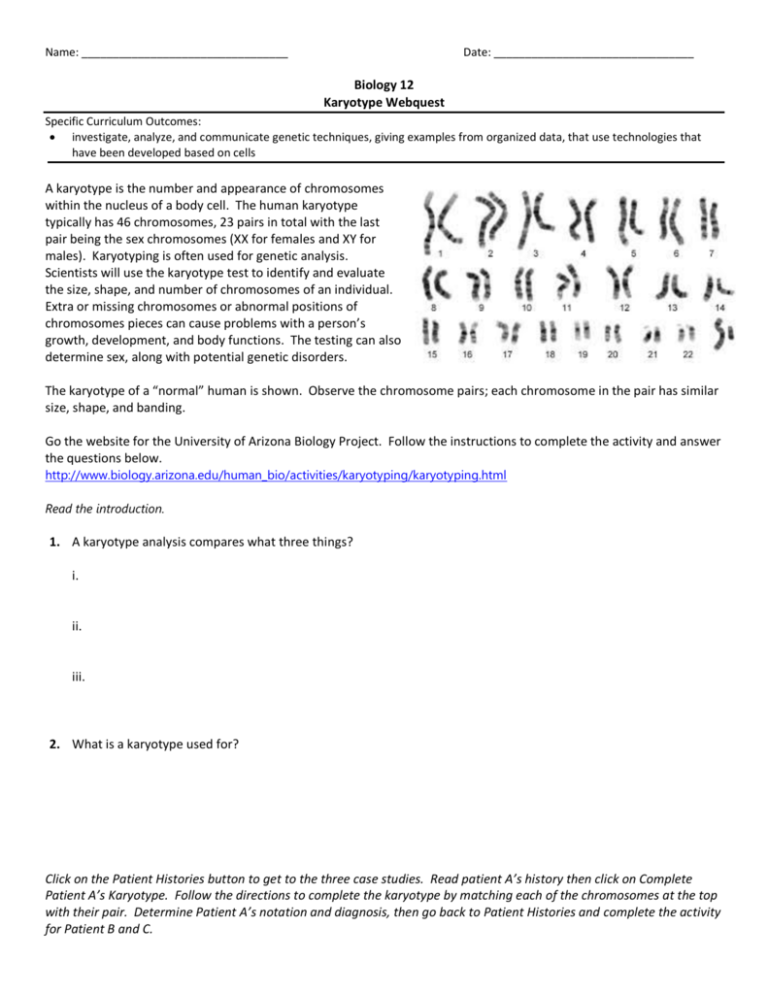
Name: _________________________________ Date: ________________________________ Biology 12 Karyotype Webquest Specific Curriculum Outcomes: investigate, analyze, and communicate genetic techniques, giving examples from organized data, that use technologies that have been developed based on cells A karyotype is the number and appearance of chromosomes within the nucleus of a body cell. The human karyotype typically has 46 chromosomes, 23 pairs in total with the last pair being the sex chromosomes (XX for females and XY for males). Karyotyping is often used for genetic analysis. Scientists will use the karyotype test to identify and evaluate the size, shape, and number of chromosomes of an individual. Extra or missing chromosomes or abnormal positions of chromosomes pieces can cause problems with a person’s growth, development, and body functions. The testing can also determine sex, along with potential genetic disorders. The karyotype of a “normal” human is shown. Observe the chromosome pairs; each chromosome in the pair has similar size, shape, and banding. Go the website for the University of Arizona Biology Project. Follow the instructions to complete the activity and answer the questions below. http://www.biology.arizona.edu/human_bio/activities/karyotyping/karyotyping.html Read the introduction. 1. A karyotype analysis compares what three things? i. ii. iii. 2. What is a karyotype used for? Click on the Patient Histories button to get to the three case studies. Read patient A’s history then click on Complete Patient A’s Karyotype. Follow the directions to complete the karyotype by matching each of the chromosomes at the top with their pair. Determine Patient A’s notation and diagnosis, then go back to Patient Histories and complete the activity for Patient B and C. Name: _________________________________ Date: ________________________________ 3. Patient A Notation: ___________________________ Diagnosis: ___________________________ 4. Patient B Notation: ___________________________ Diagnosis: ___________________________ 5. Patient C Notation: ___________________________ Diagnosis: ___________________________ Answer the following questions. 6. Are the following diagnoses classified as monosomy or trisomy? What does that indicate? 7. What causes each of the following diagnoses? What is the proper name of this event? 8. Could karyotyping be used for designer babies? Explain. Name: _________________________________ Date: ________________________________ Biology 12 Karyotype Webquest Answers Specific Curriculum Outcomes: investigate, analyze, and communicate genetic techniques, giving examples from organized data, that use technologies that have been developed based on cells A karyotype is the number and appearance of chromosomes within the nucleus of a body cell. The human karyotype typically has 46 chromosomes, 23 pairs in total with the last pair being the sex chromosomes (XX for females and XY for males). Karyotyping is often used for genetic analysis. Scientists will use the karyotype test to identify and evaluate the size, shape, and number of chromosomes of an individual. Extra or missing chromosomes or abnormal positions of chromosomes pieces can cause problems with a person’s growth, development, and body functions. The testing can also determine sex, along with potential genetic disorders. The karyotype of a “normal” human is shown. Observe the chromosome pairs; each chromosome in the pair has similar size, shape, and banding. Go the website for the University of Arizona Biology Project. Follow the instructions to complete the activity and answer the questions below. http://www.biology.arizona.edu/human_bio/activities/karyotyping/karyotyping.html Read the introduction. 1. A karyotype analysis compares what three things? i. length ii. position of centromere iii. location and sizes of G bands 2. What is a karyotype used for? Karyotyping is one of many techniques that allow us to look for several thousand possible genetic diseases in humans. Click on the Patient Histories button to get to the three case studies. Read patient A’s history then click on Complete Patient A’s Karyotype. Follow the directions to complete the karyotype by matching each of the chromosomes at the top with their pair. Determine Patient A’s notation and diagnosis, then go back to Patient Histories and complete the activity for Patient B and C. Name: _________________________________ Date: ________________________________ 3. Patient A Notation: 47, XX, +21 Diagnosis: Down’s Syndrome 4. Patient B Notation: 47, XXY Diagnosis: Klinefelter’s Syndrome 5. Patient C Notation: 47, XY, +13 Diagnosis: Trisomy 13 Syndrome Answer the following questions. 6. Are the following diagnoses classified as monosomy or trisomy? What does that indicate? All three are trisomy, meaning an extra chromosome. 7. What causes each of the following diagnoses? What is the proper name of this event? Non-disjunction; the tetrads or the sister chromatids did not properly separate during meiosis. 8. Could karyotyping be used for designer babies? Explain. Yes, it could be used to determine chromosome numbers to ensure a “healthy” embryo.
